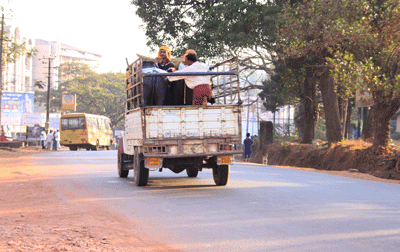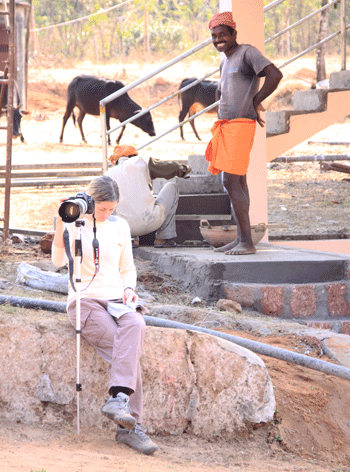

Michael Palin To Mangalore

As we glided onto the hilltop runway of Mangalore airport, surrounded by a lush landscape of padi fields and coconut groves spread out below us, anticipation of what awaited set in. Our cab driver picked us up and we started the 40km drive towards our hotel in Moodabidri. This was my first truly awake encounter with India, the warm light, vibrantly coloured housing and mad driving. We drove past large billboards advertising the Kambala between the airport and the hotel.
Outside the window of our small yellow taxi was the buzz of rural life, a freeness of interaction, welcoming smiles and gestures. This was the constant energy of independent purpose, a hectic nature that somehow seemed to work.
Forty minutes later we arrived in Moodabidri. where we were warmly greeted at the Hotel, 32 hours after we had left Heathrow. At 5pm, After a short siesta we felt fit enough to embark on a walk into Moodabidri town centre. The first conscious contact with the Indian traffic was sobering but showed us the wonderful world of orderly chaos: from buses with open doors and partially hanging out passengers to overloaded tuk tuk's sounding to like angry mosquitos, to lorries with livestock. We began envisaging what the Indian road traffic act must contain: 1.) Your horn is your best friend 2.) who brakes will lose 3.) road markings and traffic lights are pretty but not interesting.
Two days before the Kambala, a tangible excitement could be felt in the centre of Moodabidri town as the market wound down for the evening. As Stefan and I walked through the town centre I wanted to absorb everything, the sight of overloaded buses, the constant honking horns, cricket being played on a large area of red dust that glowed in the evening sunlight. As dusk approached we made our way back to the hotel, the bottles of water we had purchased became heavier as we began to feel the 32 hours of travelling in our weary limbs. Large bats swooped and circled from tall coconut palms and the chirrups of crickets rang loud in the night air as we entered our hotel for our first Indian meal.
Day 1 Preparation
Our Equipment
|

We had arrived on a Thursday so we could witness the setting up of the Kambala as well as the racing itself. On Friday morning after breakfast we set out to walk to the Kambala venue that was down a winding road from the centre of Moodabidri and about 4 km from our hotel.
We past beautifully coloured housing, building sites with distinctive wooden scaffolding made with whole tree branches, lush padi fields with sentinel like white egrets on patrol. The morning was a pleasant 27 degrees, we had armed ourselves with pale clothing, and sunblock before we loaded up with food, water and camera equipment.
We arrived mid morning to the Kambala track and were met by inquisitive locals thinking we had come too early. A short explanation of what we are doing and why was greeted with warm expressions. The Kambala track was before us, two racing lines at least 100 metres long and 5 metres wide formed a shallow pit, filled with about 6 inches of water. At one end there was a larger area of open water which as we learnt became like a buffalo paddock, where the racers would line up to prepare to be bought to the start line.
A number of people walked along the walls of the track, bucket of lime wash in one hand a large brush in the other, they white washed as they went, covering all the walls of the race track. In the finishing area the two level commentary and judges area was being finished, the freshly laid cement drying in the mid morning sun.
We set up our camera equipment as I tried to understand how the sun moved during the day and how it would affect the racing to come. The water filled race track was sunk into the ground, so as the buffalo reached the finish line they had to ascend up a slope of sand to slow them down. The fact that the main racing lanes were sunk into the ground like this meant that it would be challenging to achieve the angle of the composition I wanted.
Works of Dynamic Realism confront the viewer with interaction, they are not works that can be casually observed. The aim of producing a Kambala painting is to give the viewer a sense that they are in the way of the racing buffalo, the buffalo's speed, strength and weight needed to be 'felt' and 'heard' by the viewer as the buffalo travelled across and out of the canvas. |
The sunken racetrack made getting such an affronting image difficult to capture, to take images normally of Kambala would mean looking slightly down on the racers. Determined to find a way to shoot the racers and get the angles I was looking for, I began to scout out positions, speaking with the organisers to understand what would be both safe and possible and what would not interfere with the Buffalo and their runners concentration. It wasn't long before I realised I would be getting very wet and very muddy during the shooting.
By lying along the slightly raised walls of the race track and with the camera held as low as possible, their was a chance – if the buffalo raced along the middle of their lane or against the wall that divided the two track lanes, such a compositional frame or frames could be achieved, but only at certain times of the day due to the shadows of the spectator stands covering the racing lane I was interested in after 2.30pm.
The locals seemed puzzled why we spent so long assessing positions, drawing diagrams of sun positions, field, depth of view and taking shots when their was no racing going on. But we knew we had two days, limited positions, challenging light, over 200 racers and no guarantee of how and where in the lanes the buffalo would chose to run.
We also began to learn the rules of Kambala and how to recognise the 'best' racing technique, which meant a smaller percentage of the buffalo were worth shooting, which I hoped would run on the more favourable racing line. There was more risk than I had anticipated for not getting the shots I had in mind and as we walked back towards the hotel in the late afternoon, concern crept in to my mind. Getting some success on the first days shoot I hoped would ease the pressure off.

